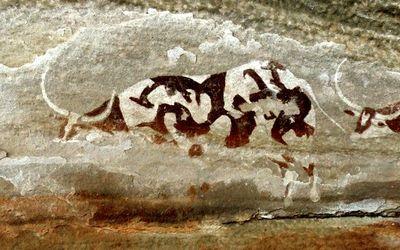Rehana Rossow
Source - http://www.bdlive.co.za/life/2014/07/31/when-sahara-was-green?

Bovids in the Tassili n Ajjer National Park in Algeria, Cattle were domesticated in Africa about 10,000 years ago. Picture: WITS ORIGINS CENTRE/TRUST FOR AFRICAN ROCK ART
Millions of South Africans will never cross the Limpopo River to travel north. But 1.8-million years ago, Homo erectus stood up, crossed that river, traversed the savannah and the jungles of central Africa, trudged across what is now the Sahara desert, wandered along the southern Mediterranean, crossed the Levant and entered Europe.
Recent discoveries by archaeologists, palaeontologists and genetic scientists have conclusively proven that all human life began in Southern Africa, and that Homo sapiens took technology with them in the second exodus out of Africa that allowed for the creation of settlements and human society.
This journey, and more, is on display at the Origins Centre at the University of the Witwatersrand. Its flagship exhibition for the year — Sahara, which runs until October 15 — provides a fascinating glimpse into the world’s hottest desert, equal in size to North America.
To reach the exhibition, visitors climb stairs covered in hessian cloth to mimic a nomad’s tent, while fans and hidden speakers batter them with the wail of the Harmattan winds that built the massive Sahara dunes over millennia.
When early humans traversed the region, the Sahara was wet and green enough to sustain animal and human populations. The area has undergone several enormous variations between wet and dry due to a 41,000-year cycle in which the tilt of earth’s axis changes between 22° and 24.5°. It is expected that, 15,000 years from now, the Sahara will be green again.
Homo sapiens travelled north during the Middle Stone Age. Archaeologists were long perplexed by the absence of stone tools along the Nile River.
"It had always been assumed that humans travelled north along the Nile," says Lara Mallen, curator of the Sahara exhibition. "That was until two years ago, when stone tools were found in western Sahara and subsequent radar imagery showed two huge ancient rivers that had flowed through what is now desert into the Mediterranean."
The warm, moist climate during the Holocene era allowed humans to develop from hunter gatherers to sedentary farmers. About 10,000 years ago, cattle were domesticated in Africa — a great leap forward for humankind. Goats and sheep were added to domestic herds, and when camels were introduced from Asia, people living in the Sahara were able to forge trade routes, even as sand dunes rose and water sources dried up.
A cemetery recently discovered in Niger is rich with fossil remains and rock art, including pictures of elephants, hippos and crocodiles — signalling an ancient lake that had dried up during a dry spell in the Sahara.
"The Sahara wasn’t the tropical Eden many early European explorers mythologised," Mallen says. "During wet spells there would have been small patches of water flanked by long grass. When the water dried up both human and animals were forced to learn to survive. One of the biggest lessons the Sahara can teach today is human adaptation to climate change. We have adapted before and we can learn to adapt again."
Gathering scientific knowledge about the desert remains a daunting task. The climate is intimidating enough, but this is aggravated by constant political turmoil in the 11 countries the Sahara covers.
"It is difficult to conduct archaeological research in areas populated by desperate people — from fleeing refugees to al-Qaeda-aligned armed groups," says Mallen. "But in recent years some myths have been busted. There is now evidence that seeds and cattle were domesticated by the Nubians. Previously we thought agriculture developed in the Levant. The earliest evidence for milking comes from the Sahara. With the skeletal evidence collected we can do facial reconstruction and this, combined with rock art, proves that agriculture was first developed by Africans."
The Origins Centre has secured several stunning photographs of Saharan rock art from Paris, where some of the biggest collections of ancient African artefacts are still held after centuries of cultural vandalism. They have loaned a few objects from the Wits Art Museum and the Kim Sacks gallery to showcase Saharan culture.
Camels are a major source of inspiration. The Tuareg have written poetry extolling the virtues of their beasts and their women are reported to be flattered when their beauty is compared to the ungainly ships of the desert.
Before the Arabs brought Islam to the Sahara, Tuareg men — who have been traders for thousands of years — covered their faces with cloth as they headed off into the dunes on their camel trains. "The Sahara is the only place where men wear the veil, not women," says Mr Mallen.
"The Sahara is the biggest thing in Africa. Although South Africans seldom cross the Limpopo.… This exhibition will give them a small taste of this extraordinary landscape."